zur deutschen Version, Flagge klicken oder tippen

- Independent State of Samoa
- parliamentary chieftains monarchy
- own name: Malotuto'atasi o Samoa
- former name: Western Samoa
• Flags
• Historical Flags
• Meaning/Origin of the Flag
• Coat of Arms
• Meaning/Origin of the Coat of Arms
• Map
• Numbers and Facts
• History
• Origin of the Country's Name

since 1949,
National, state and merchant flag,
ratio = 1:2,
Source, by: Flags of the World






Naval Jack of the Samoa Police Service,
ratio = 1:2,
Source, by: samoa-observer.com




since 2014,
Customs flag,
ratio = 1:2,
Source, by: Flags of the World





1873–1875,
Flag of the Kingdom of Samoa,
Source, by: Flags of the World, Flaggen und Wappen der Welt




1875–1879,
Flag of the Kingdom of Samoa,
Source, by: Flags of the World, World Statesmen




1879–1887, Malietoa Dynasty,
Flag of the Kingdom of Samoa,
Source, by: Flags of the World, World Statesmen




1887–1889, Tamasese Dynasty,
Flag of the Kingdom of Samoa,
Source, by: World Statesmen, Flaggen und Wappen der Welt




1889–1900, Malietoa Dynasty,
Flag of the Kingdom of Samoa,
Source, by: Flags of the World, World Statesmen



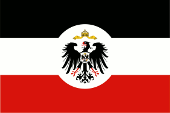
1900–1914, German Empire,
Official flag of Colonial Office,
ratio = 2:3,
Source, by: Wikipedia (DE)






1914,
planned flag for German Samoa,
ratio = 3:5,
Source, by:
Flags of the World,
Flag Reconstruction following Mark Sensen (Feb 98)
based on traditional interpretation from Afrika-Nachrichten article 1933



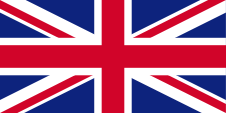
1914–1931, Union Flag → quasi National flag,
Flag of United Kingdom,
ratio = 1:2,
Source, by: Wikipedia (EN)





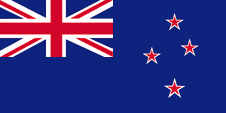
1914–1922,
State flag of New Zealand,
ratio = 1:2,
Source, by: Flags of the World






1922–1948,
Flag of the government (state flag) of Samoa,
ratio = 1:2,
Source, by: Flaggenbuch 1939




1925–1948,
Merchant flag,
ratio = 1:2,
Source, by: Flaggenbuch 1939




1922–1948,
Flag of the Governor,
ratio = 1:2,
Source, by: Flaggenbuch 1939




1948–1949,
National and merchant flag,
ratio = 1:2,
Source, by: Wikipedia (EN)




The current flag of Samoa was officially introduced on 26th of May in 1948 in connection with the adoption of a new constitution as the flag of what was then Western Samoa. It was designed by King Malietoa Tanumafili a Tupu Tamasese Mea'ole and shows a single-coloured red bunting with a blue upper corner containing five stars, the "Southern Cross". Until 1949 there were only four stars. The flag was retained when independence was achieved in 1962. Red symbolises courage and bravery, white stands for purity and blue for freedom. Blue also symbolises the sky and the sea. The "Southern Cross" can also be found in other flags of the southern hemisphere and is therefore a symbol of great regional significance.
Samoa's first flag was introduced on 2nd of October in 1873. It featured a red bunting with a blue upper corner and a white star in it. In the following years, Samoa increasingly became the focus of colonial powers, United Kingdom, the USA and the German Empire. These countries increasingly expanded their influence in the country. In doing so, they relied on various local noble families, in whose dynastic struggles for the throne of the kingdom the colonial powers interfered and supported their respective favourites. This also had an impact on the appearance of Samoa's flags. In 1875 – under direction of USA – a new model was adopted, which, similar to the flag of the USA, featured red and white horizontal stripes. The blue top corner with the star was retained. Two dynasties that finally prevailed, the Malietoa dynasty and the Tamasese dynasty, favoured their own flags, which were used as national flags during their reign between 1879 and 1900. The Malietoa dynasty used a solid white cross on a red background with a white star in the upper corner. The Tamasese dynasty used a black cross to match the German colours.
In the Samoa Treaty of 1899, Samoa was divided in two between the USA and the German Empire, while the United Kingdom was given other islands in the Pacific. The eastern part, American Samoa, remains as a dependent territory to this day. The western part (Western Samoa) became the "Colony of German Samoa" in 1900. As a German colony, the country did not use a special national flag. The colours of the German Empire were used: black, white and red. The flag of the Imperial Colonial Office was used for state purposes. This was horizontally striped in black, white and red and had a white disc with the imperial eagle in the centre. From 1913, the German Empire considered creating its own national emblems for the colonies. The first drafts were available in 1914, but the project was never realised due to the outbreak of the First World War and the loss of the colonies. Right at the beginning of the First World War, Western Samoa was approached on 27th of August in 1914 by a naval convoy of British, US and French troops and was occupied without a fight, with the administration being taken over by New Zealand officials shortly afterwards. All Germans had to leave the islands by around 1915. After the end of the First World War, the Dictate of Versailles was passed on 28th of June in 1919, a kind of peace treaty between the German Empire and the Allies. The German Empire was not involved in the negotiations and was forced to sign under threat of occupation of the motherland, thereby establishing the German Empire's sole responsibility for the war. Among other things, the German Empire lost all of its colonies, including Western Samoa, whose administration was transferred to New Zealand as a trusteeship mandate on behalf of the League of Nations in 1919. After the islands were occupied on 27th of August in 1914, the "Union Jack" was hoisted in Apia on 30th of August in 1914, underlining the future affiliation to the British Empire, in which individual citizens on land showed their status as citizens or nationals of the United Kingdom, usually by using the Union Jack, also known as the "Union Flag". For state purposes, the state flag of New Zealand was used.
In 1921, New Zealand applied to the British Admiralty for authorisation to have its own blue and red ensign (state flag and merchant flag). The blue ensign was approved in 1922, the red ensign not until 1925.
United Kingdom had introduced a flag system in 1864 in which:
• War ships use a so-called "White Ensign" (naval flag), a white flag often with a red St. George's cross throughout and with the Union Jack in the upper corner,
• Merchant ships use a so-called "Red Ensign" (also called "Civil Ensign" → citizen flag, the actual merchant flag), a red flag with the Union Jack in the upper corner, and
• Governmental ships use a "Blue Ensign" (flag of the government → the actual state flag), a blue flag with the Union Jack in the upper corner.
From 1865, ships of colonial governments were allowed to use a Blue Ensign with a badge in the flying end. For all other purposes, the British Union Jack was to be used exclusively on land and the standard red British merchant flag, the "Red Ensign", at sea. If the British Admiralty had granted the colony the appropriate authorisation, merchant ships and private seamen from these colonies were permitted to fly a Red Ensign with the bagde. The respective governments were to provide appropriate bagdes. Such a badge was often a regional landscape depiction placed on a disc, often showed ships, historical events or could just be a kind of logo. Very often a badge also showed the name of the country or a motto. The badge of Western Samoa showed three palm trees, a symbolism that goes back to the time of the German colony. Flags modelled on those of British colonies were used until 1948.
There was a governor for Western Samoa during this time, but between 1914 and 1948 he was represented locally by a military administrator. In 1948, a new constitution came into force and the office of administrator was abolished and was replaced by a civilian high commissioner. This was also reflected in the fact that the British-style flags were abolished that year and the current flag was adopted for the country. It was retained even after independence on 1st of January in 1962.
Source:
Die Welt der Flaggen,
Flaggen Wappen Hymnen,
Flags of the World,
Wikipedia (EN),
Volker Preuß


since 1951,
Coat of arms of Samoa (Western Samoa),
Source: Corel Draw 4

1914,
planned coat of arms of German Samoa,
Source, by:
Flags of the World,
Reconstruction following Mark Sensen (Feb 98)
based on traditional interpretation from Afrika-Nachrichten article 1933

1922–1948,
Badge of New Zealand Samoa,
Source, by: Flaggenbuch 1939

The current coat of arms was introduced on 12th of April in 1951, when Samoa (then Western Samoa) was still a trust territory of the UNO. For this reason, the country's coat of arms was placed over the red-coloured emblem of the United Nations. The shield shows a blue area in the centre with the "Southern Cross", green wavy lines and a palm tree at the top. The design symbolises Samoa's location in the ocean and the nature of the country. A Christian cross appears above the shield. The cross and also the country's motto, which appears below the shield in a white banner ("Fa' avaeile atua Samoa" → "May God be the foundation of Samoa") represent the influence of Christianity. The two green olive branches on the left and right are peace symbols and are part of the symbolism of the UNO emblem. The badge of New Zealand Samoa shows three palm trees, a symbolism that goes back to the time of the German colony. With the exception of Kiaochow (Kiautschou), the German colonies were under the control of the Imperial Colonial Office. Accordingly, the authorities used its seals, flags and the imperial coats of arms. From 1913, consideration was given to creating separate national emblems for the colonies. The first drafts were available in 1914, but the project was never realised due to the outbreak of the First World War and the loss of the colonies. The imaginary appearance of the coats of arms and flags could only be reconstructed in the 1920s and 1930s on the basis of fragments. Most of the reconstructions refer to an article in the newspaper "Afrika-Nachrichten" from 1933 and the subsequent reconstructions by the Dutch vexillologist Mark Sensen from February 1998, which are also taken into account on these pages. The coats of arms themselves should still bear the imperial crown above the escutcheon, but not on the flags, if one follows Mark Sensen's reconstruction. The coats of arms always had the same structure: a horizontally divided shield with the imperial eagle and the breast shield of the House of Hohenzollern on a white background. The main part was a stylised depiction of plants, animals or landscapes, which were coloured differently depending on the country. The planned coat of arms of German Samoa showed three white stylised palm trees in front of blue wavy lines on a red background.
Source:
Die Welt der Flaggen,
Flaggen Wappen Hymnen,
Wikipedia (EN),
Volker Preuß

Location:
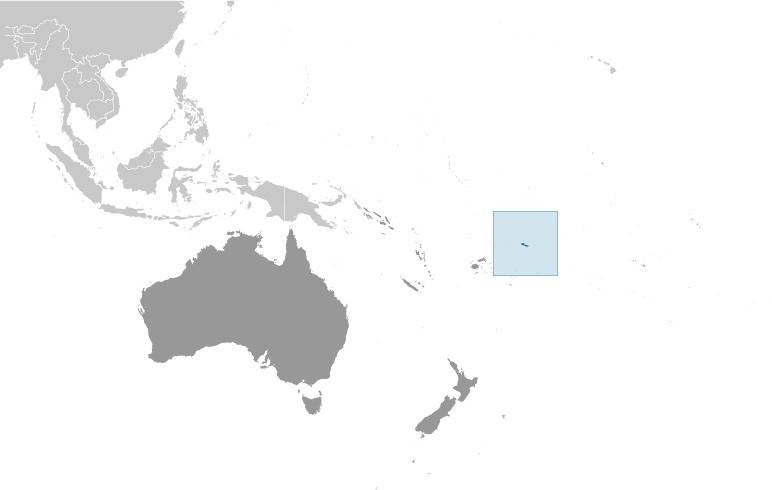
Source: CIA World Factbook
Map of the country:
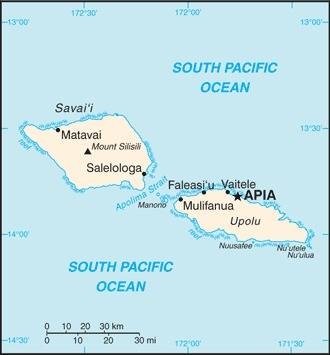
Source: CIA World Factbook

Area: 1.097 square miles
Inhabitants: 205.557 (2021), thereof 92 % Samoans, 7 % Euronesians (Mixed), 0,5 % Europeans
Religions: 79 % Protestant, 19 % Roman Catholic, 0,4 % Bahai
Density of Population: 187 inh./sq.mi.
Capital: Apia, 36.735 inh. (2011)
official Languages: Samoan, English
Currency: 1 Tala (WST, WS$) = 100 Sene
Time Zone: GMT – 11 h
Source: Wikipedia (DE)

13th of June 1722 · the Dutch navigator Jacob Roggeveen discoveres the islands of Samoa, and gives them the name "Bauman Islands" (Baumanns Eilanden)
5th of May 1768 · the French navigator Louis-Antoine de Bougainville visits the islands and gives them the name "Navigator Islands" (Îles Navigateurs)
1787 · the French navigator Jean-François de Galaup, Comte de Lapérouse visits the islands
1791 · the British navigator Edwards visits the islands
1824 · the Russian navigator Otto von Kotzebue visits the islands
1847 · United Kingdom establishes a consulate
1853 · the USA establish a consulate
1861 · Prussia establishes a consulate
2nd of November 1871 · New Zealand calls for the seizure of the islands by United Kingdom
1872 · the USA establish a shipping base in Pago Pago
1873/1874 · the Samoans make their own central government, the rule of "Taimuna and Faipule", a kind of chiefs and people's assembly
1878 · friendship treaty of the USA with the islands of Tutuila and Aunu'u
1879 · the German Empire establishes a shipping base in Saluafuta on Upolu
1879 · chief Malietoa Talavou becomes King of Samoa
1880 · Malietoa Laupepa becomes King of Samoa
1884 · King Malietoa Laupepa and Viceroy Tupua Tamasese Titiamaea want the occupation of the islands by Gread Britain
1887 · Tupua Tamasesse becomes King of Samoa, opposition from the followers of ex-King Malietoa Laupepa, Malietoa becomes captured by German troops and temporarily brought to Cameroon
1888 · the followers of ex-King Malietoa Laupepa proclaim chief Malietoa To'oa Fiame Mata'afa for King, civil war
1889 · overthrow of King Tupua Tamasesse, Malietoa To'oa Fiame Mata'afa becomes King of Samoa, Civil War, United Kingdom, USA and the German Empire send troops to restore the order
14th of June 1889 · Berlin Samoa Conference, Berlin agreements, Samoa is recognized as a kingdom, but it is a protectorate of the three powers, United Kingdom, USA and German Empire
1889 · Malietoa Laupepa becomes king again, unrests
1898 · Malietoa To'oa Fiame Mata'afa becomes king again, civil war
1899 · Malietoa Tanumafili becomes king, civil war
10th of June 1899 · provisional government of the consuls of the three powers
1st of March 1900 · Samoa Treaty, the islands divided between the USA (American Samoa) and the German Empire (German Samoa), the claims of United Kingdom become compensated with other islands in the Pacific
29th of October 1914 · First World War, troops from New Zealand occupy German Samoa
1920 · Versailles Dictate, the German Empire loses all its colonies, German Samoa becomes a Mandate Territory of the League of Nations under New Zealand mandate, rename in Western Samoa
1947 · formation of the UN trust territory of Western Samoa under administration of New Zealand
1948 · new constitution, establishment of a civil administration
1st of January 1962 · independence, as the "Independent State of Western Samoa"
1970 · Western Samoa becomes a member of the Commonwealth of Nations
1976 · Western Samoa becomes a member of the UNO
4th of July 1997 · rename in "Independent State of Samoa"
Source:
Atlas zur Geschichte,
World Statesmen,
Discovery '97,
Wikipedia (EN)

The meaning of the word "Samoa" is not known. The Europeans called them "Bauman Islands" or "Navigator Islands". After the colonial division, there was an Eastern Samoa (American Samoa) and a Western Samoa. Western Samoa became independent in 1962 and calls itself only "Samoa" since 1997.
Source: Volker Preuß


![]()
























































